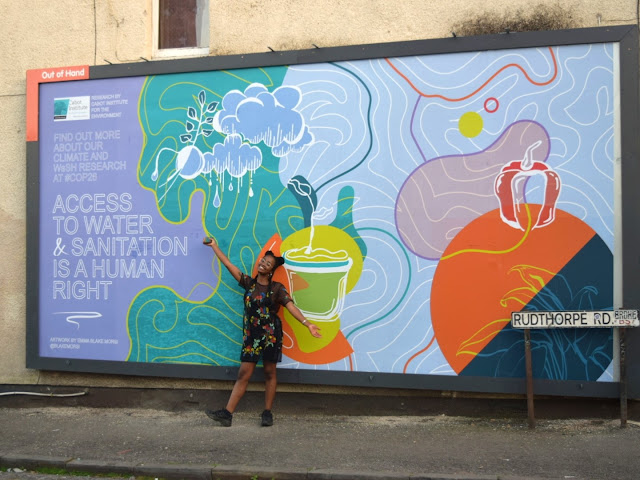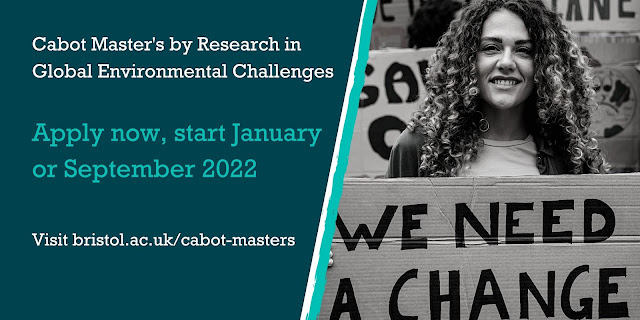What a year! Our Institute has accomplished so much, not just from the hard work of the Cabot Institute Team but also the wider Cabot academic community and beyond. We’d like to share with you some of our highlights of the year and say a big thank you to all of you who got involved and supported us along the way.
Cool collaborations
Rising Arts x Emma Blake Morsi
We collaborated with Rising Arts Agency and talented artist Emma Blake Morsi to create three pieces of art around Caboteer’s research on adaptation and resilience. Emma took that research and interpreted it in her own beautiful way to create some art which we put on billboards around the city in the Summer.
 |
| Emma Blake Morsi in front of one of the billboards she designed. |
Cabot Conversations
Adele Hulin and Amanda Woodman-Hardy worked with film company JonesMillbank and a bunch of talented artists, academics and thought leaders to create Cabot Conversations. This series of climate change conversations take place while artists work in the background, listening to the conversations and creating stunning artworks that are captured on camera in real time. The Conversations are available to watch as 30 minutes videos on YouTube and listen as 1 hour long podcasts on all good podcast platforms.
COP26
 |
| Cabot Institute at COP26 |
Cabot Annual Lecture
Over a thousand people signed up for our Annual Lecture this year, which outlined what we should be looking out for and paying attention to at COP26. We were delighted to have three external speakers: Mya-Rose Craig (Birdgirl), 19 year old British-Bangladeshi founder and President Black2Nature, naturalist, environmentalist, climate and race activist; Journalist Leo Hickman, Director and Editor of Carbon Brief; and Alyssa Gilbert, Director of Policy and Translation at the Grantham Institute for Climate Change and the Environment and chair of the COP26 Universities Network. Watch the lecture below.
Incredible Caboteers
Academics
Apart from all the awesome environmental research that our Caboteers have been contributing to, they’ve also been on your radio and telly quite a lot this year. Our members appeared over 1000 times in the press and we reached 14, 821,429,500 people and that was just for our engagement in COP26! Consider our minds officially blown!
 |
| Professor Dan Lunt on BT Sport's Playing Against the Clock programme. Watch here. |
Our academics have also been involved in some great projects this year including bringing together voices from Small Island Developing states at the sharp end of climate change; an event on Extinction Rebellion and climate change activism; Bristol's first pesticide amnesty and Waves of Change working on climate change with young people in coastal Cornish towns (see video below).
Within the core team we said a sad farewell to Professor Jemma Wadham and extended a big warm welcome to Professor Guy Howard who took over the reigns from Jemma as she moved on to an incredible role as chair at UiT Arctic University of Norway. Helen Thomas-Hughes also started as Director of the Cabot Masters in Global Environmental Challenges.
Students
It’s not just our academics who have accomplished a lot this year, our students have too. They have supported school children across the city by helping us to run a Mock COP26 and we helped 45 of them get up to Glasgow for COP26 so they could experience it and make their voices heard.
In September 2021, we were delighted to welcome our third cohort of students on our MScR in Global Environmental Challenges. This year, our student projects range from conservation and the deep sea, sustainable food systems, digital net zero and extreme heat - to name but a few!
This year also saw our MScR student Fanny Lehmann being awarded the very first Student Met Office Prize, for her outstanding thesis on "How is the global water cycle responding to climate change?", supervised by Professor Jonathan Bamber.
We also had incredible outputs from our MScR students Lucy McCarthy, Dora Young, Lois Barton and Tilly Walker-Wood who produced content for us in the run up to COP26. Other members of the cohort co-created a public engagement activity for Festival of Nature.
Cabot Communicators
Our Cabot Communicators – a group of PhD students and postdocs who we train to communicate their environmental research – had a great year too! Here are some of their outputs:
- Leanne Archer was broadcast on Greg James' Radio 1 show on the first day of COP26. If you want a masterclass in how to talk very succinctly (it's only a minute or two) in plain English and with heart about your research, this is well worth a listen at 1:03:40.
- Hilary McCarthy put together a Climate Emergency Instagram campaign for us and wrote 2 blogs:
- Ecological decline: an overlooked emergency?
- The 'Ecological Emergency' and what The Cabot Institute for the Environment are doing about it
- Olivia Reddy live-posted her visit to COP26 on Instagram for us and produced our content for our #CabotNext10 campaign (more details below).
- Moya MacDonald and Hannah Langlands did some great copywriting from two policy dissertations, shortening them down to two pages and turning them into plain English for us as part of our COP26 policy brief series which was sent out to MPs and policymakers to help inspire change from the top down.
#CabotNext10
Yep. We’re 10 YEARS OLD this year. Unfortunately, we were unable to hold our famous Cabot Celidh to celebrate due to Covid and the behemoth that was COP26, but our Cabot Communicator Olivia Reddy put together some lovely blogs for us to celebrate the last ten years and the next ten years by interviewing some of the key people in Cabot – the core Cabot Team and the leaders of our Research Themes. If you fancy finding out a bit more about where we came from, what inspires us and where we’re going, feel free to dive into these blogs.
We hope you will join us in celebrating not just our tenth anniversary but our community’s incredible achievements this year. We are in awe of their awesomeness and can’t wait to see what next year (and the next ten years!) will bring.
We hope you have a happy holiday and we’ll see you in the New Year.
 |
| Some of the Cabot Team. Left to right: Amanda Woodman-Hardy, Angus Morrice, Vicky Jones, Joanne Norris. |
--------------------------------------
This blog is written by Amanda Woodman-Hardy, Communications and Engagement Officer at the Cabot Institute for the Environment. Follow on Twitter at @Enviro_Mand.

